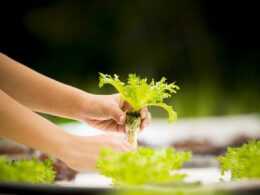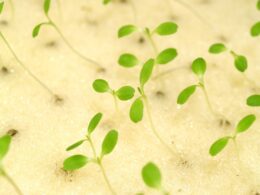Do you want to know if hydroponics can grow plants faster than soil? If you’re a gardener, farmer, or plant enthusiast, you may have asked yourself this question before.
Hydroponics is a modern way of growing plants without soil, using water and nutrient solutions instead. It’s gaining popularity for its efficiency and convenience, but is it really faster than soil growing?
In this article, we’ll explore the differences between hydroponics and soil growing, and dive into case studies and research to answer the question: does hydro grow faster than soil? We’ll also provide recommendations based on our findings, so you can make an informed decision on which method is best for your plants.
So, buckle up and get ready to learn about the fascinating world of plant growth!
Understanding Hydroponics
Get ready to learn about an innovative and exciting way to cultivate plants without using traditional soil with the method known as hydroponics. Hydroponics is a method of growing plants in water-based nutrient solutions instead of soil. This practice is rapidly gaining popularity due to the numerous benefits that it provides.
One of the biggest benefits of hydroponics is that it allows for faster growth rates and higher yields compared to traditional soil-based methods. This is because plants are provided with all the necessary nutrients and oxygen directly to their roots without any competition from other plants or soil-borne diseases. The plants can also be grown year-round, regardless of weather conditions, because they are grown indoors.
There are various popular hydroponic systems that can be used for growing plants. Some of the most common systems include drip irrigation, deep water culture, ebb and flow, nutrient film technique, and aeroponics. Each system has its own advantages and disadvantages, but all of them allow for faster growth and higher yields compared to traditional soil-based methods.
With hydroponics, you can grow healthier plants faster and more efficiently than ever before.
Soil Growing
If you’re a fan of traditional growing methods, you’ll love the soil growing process! While hydroponics is becoming increasingly popular, there’s something special about soil growing that can’t be replicated.
Here are four reasons why soil growing might be the right choice for you:
-
Soil vs Hydroponics: While hydroponics is a soil-less growing method that relies on nutrient-rich water to feed plants, soil growing utilizes natural soil. This can lead to differences in plant growth, as soil contains a range of beneficial microorganisms that can help plants thrive.
-
Organic Soil Alternatives: If you’re looking for an organic growing option, soil growing is a great choice. There are many organic soil alternatives available, such as compost and worm castings, that can be used to create a nutrient-rich soil mix for your plants.
-
Cost: Soil growing can be more cost-effective than hydroponics, as you don’t need to purchase expensive equipment such as pumps, timers, and reservoirs. You can simply use natural soil and add any necessary amendments.
-
Ease of Use: Soil growing is a straightforward process that doesn’t require a lot of technical knowledge. Simply plant your seeds or seedlings in the soil, water them regularly, and watch them grow!
So, if you’re looking for a more traditional, organic, and cost-effective growing method, soil growing might be the perfect choice for you. Give it a try and see the difference for yourself!
Differences between Hydroponics and Soil Growing
When it comes to hydroponics and soil growing, there are some distinct differences to consider. One major factor is nutrient uptake – hydroponic plants receive their nutrients directly from a solution, while soil-grown plants rely on the nutrients in the soil.
Additionally, hydroponics is generally more water-efficient than soil growing. These factors can impact plant growth and yield, and it’s important to understand them when deciding which method to use in your own growing endeavors.
Nutrient Uptake
You’ll notice that plants in hydroponic systems tend to absorb nutrients more efficiently than those in traditional soil-based systems. The reason for this is that in hydroponics, plants are grown in a nutrient-rich solution that is constantly circulated around their roots. This means that the nutrients are readily available for the plants to absorb at all times, leading to faster and healthier growth.
In contrast, soil-based systems require the plants to grow their roots in search of nutrients, which can be a slow and inefficient process. Additionally, soil can become depleted of nutrients over time, leading to the need for fertilization techniques to replenish them.
Overall, hydroponic systems offer a more efficient and consistent way to provide plants with the nutrients they need to grow strong and healthy.
Water Efficiency
In hydroponic systems, plants are able to absorb nutrients more efficiently due to the constant circulation of a nutrient-rich solution. This results in a more water-efficient method of growing.
Water conservation is an essential aspect of hydroponics as it uses less water than traditional soil-based growing methods. Hydroponic systems also allow for precise irrigation techniques, which control the amount of water and nutrients that plants receive. This method ensures that plants receive the necessary amount of water and nutrients without wasting any excess water.
In contrast, soil-based growing methods can lead to over-watering and the loss of nutrients through leaching. Overall, hydroponic systems offer a more water-efficient and controlled method of growing plants.
Plant Growth and Yield
Now that we’ve discussed the water efficiency of hydroponics, let’s talk about how it compares to soil in terms of plant growth and yield. Are you curious to know if hydroponics truly grows faster than soil? Well, the answer is yes!
Hydroponics allows for precise control of nutrients and water, which means plants can grow faster and produce a higher yield. Here’s some more information to keep you interested:
-
Effect of lighting: Proper lighting is crucial for plant growth in hydroponics. LED lights are commonly used because they provide the right spectrum of light for plant growth while using less energy than traditional lighting options.
-
Pruning techniques: Pruning is an important technique in hydroponics to promote healthy plant growth and increase yield. By removing dead or damaged leaves, plants can focus their energy on producing healthy new growth.
-
Comparing nutrient deficiencies: Nutrient deficiencies can occur in both hydroponic and soil-grown plants. However, in hydroponics, deficiencies can be identified and addressed more quickly because the nutrient solution can be adjusted immediately.
Overall, hydroponics allows for a more controlled and efficient way of growing plants. By understanding the effects of lighting and pruning techniques, as well as comparing nutrient deficiencies, you can ensure the best possible growth and yield in your hydroponic system.
Does Using a Hydroponic Tower Speed Up Plant Growth Compared to Soil?
Using running water in a hydroponic tower has been shown to potentially speed up plant growth in comparison to traditional soil methods. This innovative system allows plants to receive a constant supply of water and nutrients, promoting rapid absorption and growth. By bypassing the need for soil, hydroponic towers provide an efficient and controlled environment that maximizes plant development.
Case Studies and Research
You may be surprised to learn that some growers swear by hydroponics, claiming that their plants have experienced incredible growth rates and yields compared to traditional soil methods. But is there any research to back up these claims? Let’s take a look at some case studies.
One study compared lettuce grown in hydroponics to lettuce grown in soil. The results showed that the hydroponic lettuce grew faster and had a higher yield than the soil-grown lettuce. Another study compared tomatoes grown in hydroponics to tomatoes grown in soil, and found similar results – the hydroponic tomatoes grew faster and had a higher yield.
While these studies suggest that hydroponics can lead to faster growth and higher yields, it’s important to consider the environmental impact of this method. Hydroponics requires a lot of water and energy to maintain, as well as the use of fertilizers and other chemicals. On the other hand, soil-based farming can have a more natural and sustainable approach, with less reliance on artificial inputs.
In summary, while hydroponics may offer faster growth and higher yields, it’s important to weigh the potential environmental impact and sustainability of this method. As a grower, it’s up to you to decide which method works best for your needs and values.
Conclusion and Recommendations
You’ll love the conclusion and recommendations section, where we’ll summarize the key takeaways and offer suggestions for your future growing endeavors. After analyzing the case studies and research, we can conclude that both hydro and soil have their pros and cons.
Hydroponic systems tend to grow faster and produce higher yields, but they require more maintenance and can be more expensive. On the other hand, soil systems are more forgiving and require less maintenance, but the growth rate and yield may not be as high as hydroponic systems.
Here are some recommendations for your future growing endeavors:
- Consider your budget and time constraints before choosing a growing system. Hydroponic systems may produce higher yields, but they require more time and money to set up and maintain.
- Research the specific plants you want to grow and determine which system would be best suited for their needs. Some plants may thrive in hydroponic systems, while others may prefer soil.
- Experiment with both systems to see which one works best for you and your specific growing environment.
- Don’t be afraid to mix and match systems. For example, you can use hydroponic systems for faster-growing plants and soil for slower-growing plants.
- Always keep track of your maintenance requirements and adjust accordingly. Whether you’re using hydro or soil, proper maintenance is key to a successful and healthy harvest.
Incorporating these recommendations into your growing practices can help you achieve a successful and fulfilling harvest, no matter which system you choose. Remember to weigh the pros and cons of each system and adjust your maintenance requirements accordingly. Happy growing!
Frequently Asked Questions
What are the basic nutrients required for hydroponic plants?
To ensure your hydroponic plants grow strong and healthy, you need to provide them with the right nutrient solutions. These solutions should contain all the basic nutrients that plants need to thrive, such as nitrogen, phosphorus, and potassium.
You can also add plant growth enhancers to your nutrient solutions, which can help your plants grow faster and stronger. By using the right nutrient solutions and plant growth enhancers, you can create an ideal environment for your hydroponic plants to flourish.
So, whether you’re growing plants in soil or hydroponically, providing them with the right nutrients is key to their success.
Can hydroponic plants grow without any soil or medium?
If you’re interested in growing plants without soil, then hydroponic systems are a great option for you. You don’t have to worry about the quality of the soil or the amount of water the plants are receiving with soilless cultivation. Hydroponic systems provide the perfect balance of nutrients, water, and oxygen that plants need to thrive, resulting in healthy and vigorous growth. Plus, you don’t have to worry about soil-borne diseases or pests.
So if you’re looking for an efficient and safe way to grow plants, consider hydroponic systems for your next project.
What are the common types of soil used for growing plants?
When it comes to growing plants, one of the most important factors to consider is the type of soil you use. There are several different soil types commonly used for growing plants, including sandy soil, loamy soil, and clay soil.
Each type has its own unique properties that can affect plant growth. For example, sandy soil drains quickly and is great for growing plants that don’t like wet feet, while clay soil retains moisture well and is good for plants that need a lot of water.
While it’s important to choose the right soil for your plants, it’s also important to keep in mind that soil type isn’t the only factor that affects growth. Other factors, such as light, temperature, and nutrients, also play a role.
So, while hydroponic plants may grow faster than plants grown in soil, the type of soil you use can still have a significant impact on your plants’ growth.
How does the pH level affect plant growth in soil and hydroponic systems?
Soil vs Hydroponics: Which is better for Plant Growth? The answer is not so simple. While soil has been the traditional choice for growing plants for centuries, hydroponics, a soil-less method, is gaining popularity due to its ability to provide plants with nutrients more efficiently.
However, the Effects of pH on Plant Growth in Different Growing Methods is a crucial factor to consider. In soil, the pH level can affect the availability of nutrients for plants, making it important to maintain a slightly acidic soil pH level.
In hydroponics, the pH level of the nutrient solution is critical, as it directly affects the plant’s ability to absorb nutrients. Therefore, it’s essential to monitor and adjust the pH level regularly in both soil and hydroponic systems.
Ultimately, the choice between soil and hydroponics depends on your specific needs and preferences.
Are there any environmental concerns associated with hydroponic farming?
When it comes to hydroponic farming, there are definitely some environmental concerns to consider. One of the biggest issues is water usage. Hydroponic systems require a lot of water to function properly, and this can be a problem in areas where water is scarce or expensive.
Additionally, hydroponic systems tend to use more energy than traditional farming methods. This is because they require special lighting and heating systems to maintain optimal growing conditions. While hydroponic farming can be a great way to grow plants faster and more efficiently, it’s important to be mindful of these environmental concerns and take steps to minimize their impact.
Conclusion
So, does hydro grow faster than soil?
After analyzing the differences between hydroponics and soil growing, it seems that hydroponics can indeed produce faster and more abundant yields. However, it’s important to note that this is only true if the hydroponic system is properly set up and maintained.
While hydroponics does require a larger upfront investment and more attention to detail, it can ultimately provide a more efficient and effective way to grow plants. If you’re looking to maximize your yields and have the time and resources to invest, hydroponics may be the way to go. Just make sure to do your research, choose the right system for your needs, and stay on top of maintenance to ensure success.









